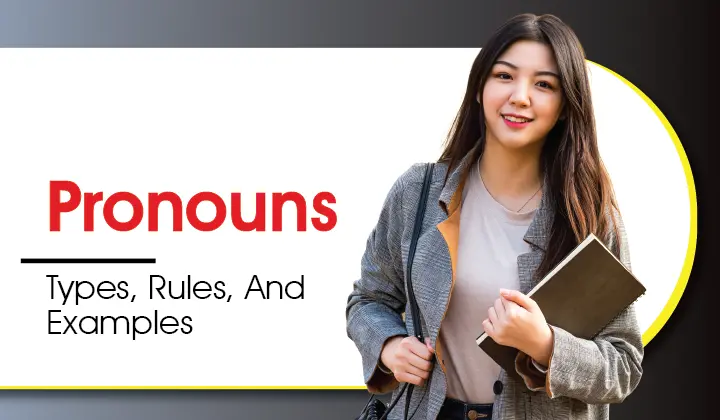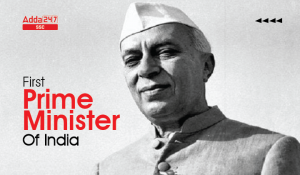Pronouns are words that are used in place of nouns to avoid repetition. Pronouns keep the communication going and they help nouns from getting repetitive or when nouns are not known. They constitute an important part of the English language sections. This topic also plays a very important role for candidates preparing for any government job exam. Those who are preparing or want to prepare for any competitive examinations must be aware of the pronouns, their rules, types, and examples. For the ease of aspirants, we are providing notes on pronouns constituting types of pronouns and rules with the help of examples.
What is a pronoun?
Pronouns are those words that we use to avoid repetition of nouns such as I, he, she, it, you, we, or they. We use these pronouns in our daily life, knowingly or unknowingly. Pronouns are one of the eight parts of speech that have different types of pronouns.
Example: My dog got injured, she fell downstairs. Here, she is the pronoun used for dog.
Types of Pronouns
There are 8 types of pronouns that have different uses and meanings in the English language. The questions asked in the competitive exam from all the pronouns. Read the below article and know all the types of Pronouns and have a better understanding of this topic.
Personal Pronouns
“A pronoun is a word used instead of a Noun”. (I, we, you, he, she, it, they) are called personal pronouns because they stand for the three persons.
|
Nominative case (Subjective)
|
Objective case
(Accusative) |
Possessive case
(Genitive)
|
|
|
First Person
|
I, we
|
me
us
|
my, mine,
our, ours
|
|
Second Person
|
you
|
you
|
your, yours
|
|
Third person
|
he
she
it
they
|
him
her
it
them
|
his
her, hers
its
their, theirs
|
Subject and object pronouns
Subject and object pronouns are used in everyday language. However, it can be tricky to remember which is which. The subject always takes action. The object is part of the activity, but it does not do any acting.
Here is an example:
(i) Shelby likes talking to Marvin.
Shelby is the subject; she likes talking. Marvin is the object; all the liking and talking is done to Marvin but not by Marvin.
Subject and object pronouns function in the same way
(i) Subject pronouns include I, you, he, she, it, they, we.
(ii) Object pronouns include me, you, him, her, it, us, them.
See the following examples:
Subject
I might see you later.
You have to come now.
She lives in Nebraska.
He makes me angry
It just might work.
They caught the last train.
We can’t see the end.
Object
Sarah hit me on the arm.
I need to tell you something.
Larry took him aside.
The message wasn’t for her.
Take it to the store.
Summer is fun for us.
Margaret took them downstairs
Possessive Pronoun
Possessive pronouns show who owns something described in a sentence. They include mine, his, hers, its, ours, yours, theirs, and theirs. Possessive adjectives are similar to possessive pronouns. However, the possessive adjective comes before the object of the sentence; the possessive pronoun is the object of the sentence.
See the difference here:
(i) That is my dog. (possessive adjective, before the object dog)
(ii) The dog is mine. (possessive pronoun, which is the object)
Reflexive Pronoun
- Example: I told myself not to bet all my money on one horse.
- Example: The robber hurt himself chasing me through the alley.
- She blamed herself for the accident.
- He is himself today.
Emphatic/Intensive Pronoun
- You wrote those words.
- This request came from the employees themselves.
- They know that the Prank was in bad taste.
- Avoid reporting things that you haven’t witnessed.
Demonstrative Pronoun
Indefinite Pronoun
Indefinite pronouns replace nouns that are not specified. They include the following: all, another, any, anybody, anyone, anything, both, each, either, everybody, everyone, everything, few, many, neither, nobody, none, no one, nothing, one, several, some, somebody, someone, and something.
- One should speak the truth.
- Somebody immediately called the doctor.
- Anybody can solve this problem.
- Nobody was present.
- Many are called, but few are chosen.
- Do good to others.
Distributive Pronoun
- Each of the boys gets a prize.
- Either of these roads leads to the railway station.
- Either of you can go.
- Neither of the accusations is true.
- You may bring any of your friends
- None of our students failed last year.
Reciprocal Pronoun
Each and one really belongs to the subject, Other and another are objects, but Each other and one another have become compound pronouns, (and are called reciprocal pronouns) and are rarely separated even by a preposition)
- The brothers quarreled with each other.
- They all gave evidence against one another.
- Jamie and Jack always sit beside each other in the break.
- They haven’t seen one another since last year.
Relative Pronoun
- She will choose the color that looks good on everyone
- She is complaining to whoever she comes across nowadays.
- There is a car in the parking lot that someone has painted a bright pink.
- Is there anyone here whose mobile phone has a signal?
- I met Hari who had just returned.
- I have found a pen which I lost.
- There is the book That you lent me.
Interrogative Pronoun
- Which one would you like?
- What is your name?
- Who will be managing the bullet?
- Whom did you tell about this?
- Whoever could have done this?
- Whichever one will you choose?
Rules and Examples: Pronouns
1. Since a personal pronoun works in place of a noun, the number, gender, and person of the pronoun must be according to the noun only.
Ex.- Ram has lost his books. (Not their)
She loves his husband. (Incorrect)
She loves her husband. (Correct)
2. When two or more singular nouns are joined by ‘And’ the Pronoun for them always in the plural number.
Ex.- Mohan and Sohan have lost their books. (Incorrect)
Mohan and Sohan have lost their books. (Correct)
3. When two or more singular nouns joined by ‘And’ are preceded by ‘Each’ and ‘Every’ the pronoun must be singular.
Ex.- Every student and every teacher took his or her seat.
Each of Ram and Shyam has done his work.
Each man and each boy in the party has got his share.
4. When a singular noun and a plural noun are combined by ‘Or’, ‘Either-or’, or ‘Neither-nor’, the singular noun usually comes first in the sentence and the pronoun must be in the plural number.
Ex.- Either the manager or his subordinates failed in their duty in sending the official message.
5. When two or more singular nouns are joined by ‘Either-or’, ‘neither- nor’ the pronoun is always in the singular form.
Ex.- Ram or Mohan should invest his money in some business.
Neither Ram nor Shyam confessed his guilt
Either Sita or Kamla forgot to take her prize.
6. ‘Either and neither’ is always used about two things or two persons, for more than two ‘Any’, or ‘None’ must be used.
Ex.- Either of the two girls can pay for it.
Neither of the two brothers has been selected.
Any one of the employees can claim it.
None of the students in this class has passed.
7. When in a sentence ‘one’ is used as the subject, all the pronouns in the sentence must be changed into ‘one’ or one’s and not his, her, or him.
One should keep one’s promise.
One should do one’s duty.
One must finish one’s task in time.
8. When any pronoun functions as the complement of the verb ‘to be’, it is always in the nominative case.
Ex.- It is me who has to go. (Incorrect)
It is I who have to go. (Correct)
It is he who is to blame. (Incorrect)
It is he who is to blame. (Correct)
It was he who could solve the problem Easily. (Correct)
9. Whenever any pronoun functions as an object of the main verb or a preposition, it is in the objective case.
Ex.- It is for him to consider. (Incorrect)
It is for him to consider. (Correct)
Ask him to go. (Incorrect)
Ask him to go. (Correct)
10. When two singular nouns joined by ‘and’ denote the same person or thing, the pronoun used for them must be singular in number. The article ‘The’ is placed before the first Noun.
Ex.- The accounts officer and treasurer should be careful in their work of keeping accounts.
11. When a personal pronoun is connected by a conjunction with some other word in the objective case, it must be in the objective (accusative) case.
Ex.- These clothes are for you and me. (not I)
12. A pronoun should be used in the objective case in a sentence beginning with Let.
Ex.- Let him go to his office
Let her submit the records in time.
13. While confessing a fault (or expressing a negative idea) the sequence of the personal pronouns should be as follows.
I, you, and he are in the wrong and will be punished.
[First person first, second person next and third person last]
14. While expressing a positive idea or praise, the sequence of the personal pronouns should be as follows.
You, He, and I will get an award for the good work we have done.
[Second person (2), third person (3), and first person (1)]
You, he, and I have finished the work.
Ram, you have finished your studies. (Incorrect)
You, Ram, and I have finished our studies. (Correct)
15. After ‘But’, ‘Except’, ‘Between’, and ‘Let’ the pronoun is used in the objective case.
Ex.-Everyone laughed but I. (Incorrect)
Everyone laughed but me. (Correct)
None attended the meeting except him. (Incorrect)
None attended the meeting except him. (Correct)
Let us laugh away our sorrows. (Incorrect)
Let us laugh away our sorrows. (Correct)
This is between you and I. (Incorrect)
This is between you and me. (Correct)
16. ‘Some’ is used in affirmative sentences to express quantity or degree. ‘Any’ is used in Negative or interrogative sentences.
Ex.-I shall buy some apples.
I shall not buy any apples.
Have you bought any apples?
I shall read any book. (Incorrect)
I shall read some book. (Correct)
17. When a pronoun stands for a collective noun, it must be in the singular number and in the neuter gender if the collective noun is viewed as a whole.
The jury gave its verdict.
The Jury were divided in their opinions.
18. (a) Each other is used for two persons.
The two brothers disliked each other.
Romeo and Juliet loved each other.
The two children quarreled with each other.
18.(b) One another is used for more than two persons.
Ex.-Good boys do not quarrel with one another.
All the students in the class are friendly, they like one another.
19. The pronouns who, whom, whose are generally used for persons
Who- Nominative case
Whom- Objective case
Whose-Possessive case
Ex.-Shikha is the student who got an award.
They are the thieves whom the police caught.
This is the student whose certificates are lost.
20. Use of ‘Which’
(a) For infants, small animals, and objects.
This is the baby that was lost in the theater.
This is the dog that my friend bought from the U.S.
(b) When selection is expressed.
Which of these television sets do you want to purchase?
(c)To refer to a sentence.
He was said to be drunk, which was not true.
21. Uses of ‘That’
(a) For persons, lifeless things, and small animals in the singular or the plural number.
This is the girl who failed in the exam.
This is the Radio that I bought Yesterday.
(b) As a substitute for a singular noun already mentioned.
The weather in Hyderabad is far better than in Chennai. (Wrong)
The weather in Hyderabad is far better than that in Chennai. (Right)
| SSC CGL 2024 – Related Links | |
| SSC CGL 2024 Notification | SSC CGL Vacancy 2024 |
| SSC CGL Eligibility Criteria 2024 | SSC CGL Previous Year Question Paper |
| SSC CGL Selection Process 2024 | SSC CGL Salary 2024 |




 Free Study Material for SSC CGL 2025, Do...
Free Study Material for SSC CGL 2025, Do...
 Reasoning Topics Asked in SSC CGL Exam L...
Reasoning Topics Asked in SSC CGL Exam L...
 Pandit Jawaharlal Nehru, First Prime Min...
Pandit Jawaharlal Nehru, First Prime Min...









